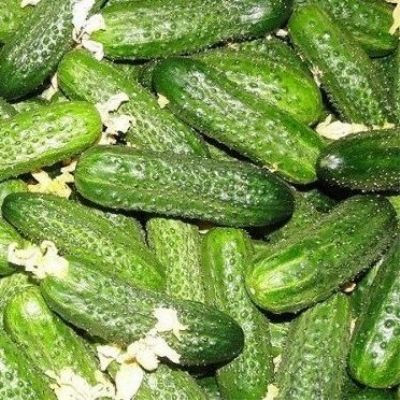
- Authors: Gavrish S.F., Portyankin A.E., Shamshina A.V., Shevkunov V.N., Khomchenko N.N., Surovova T.Ya., Pluzhnik I.S.
- Year of approval: 2011
- Growth type: vigorous, indeterminate
- Branching: the average
- Fruit weight, g: 120
- Fruit length, cm: 10-12
- Fruit color: green with short stripes and sparse mottling
- Ripening terms: early
- Fruit shape: cylindrical
- Fruit taste: great, sweet
Cucumber Khrustyk attracts summer residents with excellent taste characteristics that justify the appetizing name. Also, gardeners are pleased with the yield indicators and the early appearance of fruits, which makes it possible to decorate the table with fresh salads already in the middle of summer.
Description of the variety
The hybrid is equally suitable for growing in beds and for film greenhouses. The variety is unpretentious, resistant to adverse weather conditions. Moreover, cucumbers have an excellent presentation and a wide culinary purpose.
Characteristics of the appearance of plants and zelents
Vigorous indeterminate bushes are distinguished by medium branching. The leaves are rather large and have a rich green tint. During the fruiting period, 7–8 cucumbers appear in each bunch. The fruits are characterized by a cylindrical, slightly pointed shape. The color is green with short stripes and sparse spotting. The skin is dense, large tuberous. Vegetables look very attractive.
Purpose and taste of fruits
Cucumbers of this variety are considered salad. Delicate but crunchy flesh without voids and seeds ideally complements tomatoes and other fresh vegetables. Thanks to the juicy sweet taste, the fruits are also good in slices. They are also great for pickling and canning.
Maturation
From the appearance of the first shoots to the beginning of the fruiting period, only 44–48 days pass. If we consider that the sowing of cucumbers for seedlings is carried out in April, and they are planted on the site in May, the variety can be called early.
Yield
On average, a gardener can collect 14.4-15.3 kg of fresh cucumbers of this variety from 1 m 2. It is worth removing fruits from the bushes daily. This allows you to make room for new vegetables in a timely manner. The harvest should be stored in a cool room (cellar, refrigerator). However, even at room temperature, it retains its freshness and wonderful taste characteristics for a long time.
Growing regions
The variety is successfully cultivated in the north and north-west of the country, in the central regions, Volgo-Vyatka and Central Black Earth regions. It is also grown in the North Caucasus, the Urals, Western and Eastern Siberia.
Landing scheme
Experts advise planting plants at a distance of 30 cm from each other. The recommended spacing between rows is 70 cm. With this arrangement, the bushes will be able to reach their optimal size without intertwining or interfering with each other, and also give the greatest yield. It is better to choose a place for culture in the sun or in partial shade.
Growing and care
Agrotechnology for this variety is generally traditional. Watering is recommended in the evening with warm water. This should be done every 2-3 days. Top dressing is introduced during the growing season. In total, before the start of fruiting, the bushes should be fertilized 3 times. First, nitrogen is introduced into the soil. Then (during the flowering of the bushes) the soil is enriched with phosphorus. The third feeding is done just before the vegetables appear. During this period, the culture needs potassium and nitrogen. Also, do not forget about regular hilling, garter and shaping (the best option is in 1 stem).

In order to collect strong, tasty and beautiful cucumbers on your site, you need to make top dressing. Lack of nutrients can negatively affect the appearance of the plant and significantly reduce the yield. Fertilize cucumbers with organic fertilizers in combination with mineral fertilizers. With the right balance of these components and adherence to the fertilizing schedule, the cucumber yield will be maximum.
Disease and pest resistance
When creating a hybrid, a special task of scientists was to achieve excellent immunity. They succeeded. The crisp is resistant to most diseases, including powdery mildew and cladosporiosis. Only an invasion of a spider mite can pose a small danger. Also, in conditions of high humidity and when plantings are thickened, bushes can be exposed to downy mildew. In such cases, it is worth using the appropriate chemicals from specialty stores.

Despite their popularity, cucumbers are often attacked by diseases and pests. From them, cucumber plantings often die before the start of fruiting. In order to prevent this from happening, it is necessary to try to prevent ailments or get rid of them at the very beginning, having studied in detail their causes of occurrence, signs and methods of treatment.
Review overview
Summer residents really like this variety of cucumbers. The bountiful harvest, which is obtained even with sudden changes in temperature and other weather vagaries of summer, pleases me. The taste of the fruit is fully consistent with the declared one. Sweet, crispy vegetables are good both fresh and canned. Of the minuses, only the impossibility of collecting seeds from the fruits themselves is noted. However, the advantages of a hybrid described above easily cover this minor nuance.





























































































